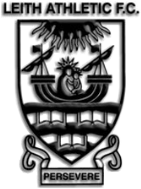
Leith Athletic Football Club is a football club based in the Leith area of Edinburgh, Scotland. They compete in the East of Scotland Football League, First Division. First team matches are played at Meadowbank Stadium.
St Bernard's Football Club were a football club based in Edinburgh, Scotland. The club was established in 1878 and joined the Scottish Football League. Their biggest success came in winning the 1894–95 Scottish Cup. They played at several different grounds before making the Royal Gymnasium Ground their long-term home. However, after having to sell it in 1943, the club was dissolved.

Alexander McMahon was a Scottish footballer who spent most of his career with Celtic.

Hampden Park in Glasgow is the primary home stadium for the Scotland national football team. This has been the case since 1906, soon after it opened. The present site of Hampden Park is the third location to bear that name and both the previous locations also hosted Scotland games. Scotland have also played many of their home games in other stadiums throughout their history, both in friendly matches and for competitive tournaments.
James Blessington was a Scottish football player and manager.
Renton Football Club was a football club based in Renton, West Dunbartonshire, Scotland. Formed in 1872, it was a prominent team in the early history of Scottish football, and was one of the teams that featured in the first ever Scottish Cup fixture. It won the competition twice, in 1885 and 1888, and was also runners-up three times. Its 6–1 win against Cambuslang in 1888 is the joint record win in a Scottish Cup final.
Cambuslang Football Club was a Scottish football club, based in the Cambuslang area. Cambuslang was one of the founding members of the Scottish Football League, but left the league after just two seasons.
The Scottish League XI was a representative side of the Scottish Football League. The team regularly played against the (English) Football League and other national league select teams between 1892 and 1980. For a long period the annual fixture between the English and Scottish leagues was only second in importance to the matches between the two national teams. The fixture declined in importance after regular European club competition was instituted in the 1950s; matches in the 1960s and 1970s were played irregularly and poorly attended. A match involving a Scottish League XI was last played in 1990, to mark the centenary of the League.
Thistle Football Club was a 19th-century football club based in Glasgow. The club was briefly a member of the Scottish Football League Division Two, and has been described as the most insignificant and least successful to have entered the league. They played at Braehead Park during their Scottish League season.
Allan Martin was a Scottish footballer who played for Rangers, Leith Athletic, Celtic and Hibernian. He finished as the top scorer in the Scottish Football League Division One in the 1895–96 season.
Hibernian Park was the home ground of the Scottish football club Hibernian from 1880 until the club's dissolution in 1891. When the club was reformed in 1892, the club took out on a lease on a site which became known as Easter Road. Hibernian Park was also located in the Easter Road area; in fact, it was closer to Easter Road itself than the present stadium because it was on the site of what is now Bothwell Street.
Tontine Park was a football ground in Renton, West Dunbartonshire, Scotland. It was the home ground of Renton F.C. from 1878 until 1922, including their time in the Scottish Football League.

George Campbell was a Scottish footballer who played in the Football League for Aston Villa.
The Football World Championship, also known as the United Kingdom Championship or the International Club Championship, was an exhibition association football match played between the English and Scottish club champions on a regular, but not annual, basis in the late 19th and early 20th centuries, with varying degrees of press attention and public interest. Perhaps the most widely publicised at the time under the 'World Championship' name was the 1888 event between Renton and West Bromwich Albion, while in the modern age interest from historians has drawn more attention to matches involving Sunderland, particularly the 1895 match. The FA Cup and Scottish Cup were qualification of the tournament.
Barrowfield Park was a football ground in the Bridgeton / Dalmarnock area of Glasgow, Scotland. It was the home ground of Eastern during the 1870s and Clyde between 1877 and 1898.
Beechwood Park, initially known as Bank Park, was a football ground in the Leith area of Edinburgh, Scotland. It was the home ground of Leith Athletic during their first seven seasons in the Scottish Football League (SFL).
Braehead Park, originally known as Hibernian Park, was a football ground in the Oatlands area of Glasgow, Scotland. It was the home ground of Glasgow Hibernian from 1889 until 1890, then used by Thistle from 1892 until they folded in 1895.
Hyde Park was a football ground in the Springburn area of Glasgow, Scotland. It was the home ground of Northern throughout their existence.
Ibrox Park was a football ground in Ibrox, Scotland. It was the home ground of Rangers from 1887 until they moved to the adjacent second Ibrox in 1899. The ground staged the Scottish Cup Final four times and also three Scotland international matches.
Glasgow Hibernian Football Club was a football club based in Glasgow, Scotland which existed for little over a year between 1889 and 1890.




